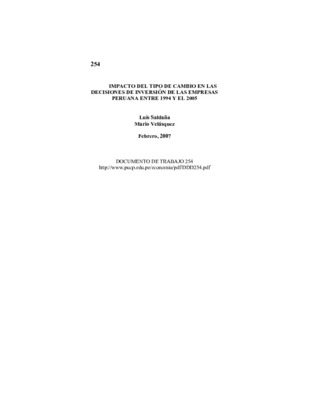| dc.contributor.author | Saldaña, Luis | |
| dc.contributor.author | Velásquez, Mario | |
| dc.date.accessioned | 2015-03-19T20:37:46Z | |
| dc.date.available | 2015-03-19T20:37:46Z | |
| dc.date.issued | 2007 | |
| dc.identifier.uri | http://repositorio.pucp.edu.pe/index/handle/123456789/46894 | |
| dc.description.abstract | La presente investigación examina los potenciales efectos negativos de una devaluación en una economía como la peruana a través de un análisis microeconómico de hoja de balance. Se analizan 182 empresas no financieras, y se demuestra que una devaluación por si sola, no es suficiente para garantizar un efecto negativo sobre el comportamiento de la inversión de las empresas peruanas. Se necesita, adicionalmente de un alto grado de dolarización de pasivos y de un contexto de inestabilidad financiera para que el efecto hoja de balance opere perniciosamente. Por otro lado, se determinó que la existencia de dos factores adicionales tienden a potenciar el efecto nocivo de las devaluaciones: (i) los periodos de recesión económica y (ii) el tamaño pequeño de las empresas. En este último aspecto se encontró que el referido efecto hoja de balance es asimétrico, debido a de que impacta con mayor intensidad a las empresas pequeñas. | es_ES |
| dc.description.abstract | This paper examines the potential negative effects produced by a devaluation on an economy as the Peruvian utilizing a microeconomic analysis. The authors have examined the balance sheets pertaining to 182 non-financial companies and they have demonstrated that a devaluation for itself is not sufficient to guarantee a negative effect on the Peruvian companies’ levels of investment and production. It is necessary an additional high degree of dolarización of passives and a context of financial instability in order that the Balance-Sheet effect operates perniciously. On the other hand, it has been determined that the existence of two additional factors tends to promote the harmful effect of a devaluation: (i) the periods of economic recession, and (ii) the small size of firms. Concerning this last factor, it has been determined that the Balance-Sheet Effect operates asymmetrically since it strikes to small companies with a higher intensity. | en_US |
| dc.language.iso | spa | es_ES |
| dc.publisher | Pontificia Universidad Católica del Perú. Departamento de Economía | es_ES |
| dc.relation.ispartofseries | Documento de Trabajo;254 | es_ES |
| dc.rights | info:eu-repo/semantics/openAccess | es_ES |
| dc.rights.uri | http://creativecommons.org/licenses/by-nc-nd/2.5/pe/ | * |
| dc.subject | Pequeñas empresas--Perú--1994-2005 | es_ES |
| dc.subject | Tipo de cambio--Perú--1994-2005 | es_ES |
| dc.title | Impacto del tipo de cambio en las decisiones de inversión de las empresas peruanas entre 1994 y el 2005 | es_ES |
| dc.title.alternative | The impact of the exchange rate on the investment decisions of Peruvian companies between 1994 and 2005. | en_US |
| dc.type | info:eu-repo/semantics/workingPaper | |
| dc.type.other | Documento de trabajo | |
| dc.subject.ocde | http://purl.org/pe-repo/ocde/ford#5.02.00 | |
| dc.publisher.country | PE | |


